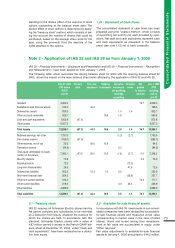APC 2005 Annual Report Download - page 78
Download and view the complete annual report
Please find page 78 of the 2005 APC annual report below. You can navigate through the pages in the report by either clicking on the pages listed below, or by using the keyword search tool below to find specific information within the annual report.
76
Changes in fair value are accumulated in equity under
"Other reserves" up to the date of sale, at which time
they are recognized in the income statement. Unreal-
ized losses on assets that are considered to be per-
manently impaired are recorded under "Finance costs
and other financial income and expense, net".
Loans, recorded under "Other financial assets", are
carried at amortized cost and tested for impairment if
there is any indication that their recoverable amount
may be less than their carrying amount. Long-term
financial receivables are discounted when the impact
of discounting is material.
1.12 - Inventories and work in process
Inventories and work in process are stated at the lower
of cost (generally determined by the weighted-average
cost method) or estimated net realizable value.
Net realizable value corresponds to the estimated sell-
ing price net of remaining expenses to complete
and/or sell the products.
Impairment losses on materials are recognized in
"Cost of sales" and on finished products in "Selling,
general and administrative expenses".
The cost of work in process, semi-finished and fin-
ished products includes direct materials and labor
costs, subcontracting costs, production overheads
based on normal capacity utilization rates and the por-
tion of research and development costs related to the
production process (corresponding to the amortization
of capitalized projects in production and product and
range maintenance costs).
1.13 - Accounts receivable
An allowance for doubtful accounts is recorded when
it is probable that receivables will not be collected and
the amount of the loss can be reasonably estimated.
Doubtful accounts and the related allowances are
identified and determined based on historical loss
experience, the age of the receivables and a detailed
assessment of related credit risks. Once it is known
with certainty that a doubtful account will not be col-
lected, the doubtful account and the related allowance
are written off to the income statement.
Accounts receivable in more than one year are dis-
counted in cases where the discounting adjustment is
material.
1.14 - Deferred taxes
Deferred taxes, corresponding to temporary differ-
ences between the tax basis and reporting basis of
consolidated assets and liabilities, are recorded using
the balance sheet liability method. Deferred tax assets
are recognized when it is probable that they will be
recovered at a reasonably determinable date.
Future tax benefits arising from the utilization of tax
loss carryforwards (including amounts available for
carryforward without time limit) are recognized only
when they can reasonably be expected to be realized.
Deferred tax assets and liabilities are not discounted.
Deferred tax assets and liabilities that concern the
same unit and are expected to reverse in the same
period are netted off.
1.15 - Cash and cash equivalents
Cash and cash equivalents presented in the balance
sheet consist of cash, bank accounts, term deposits of
three months or less and other liquid marketable
securities. Substantially all marketable securities rep-
resent short-term instruments that can be easily con-
verted into a determinable cash amount, such as
commercial paper, mutual funds and equivalents. In
light of their nature and maturities, these instruments
carry virtually no risk of impairment. The Group treats
them as cash equivalents.
1.16 - Treasury stock
Schneider Electric shares held by the parent compa-
ny or by fully consolidated companies are measured
at cost and deducted from equity. They are held at
their acquisition price until sold.
Gains and losses on the sale of treasury stock are
recognized in equity, net of tax.
1.17 - Pensions and other post-employment
benefit obligations
Depending on local practices and laws, the Group’s
subsidiaries participate in pension, termination bene-
fit and other long-term benefit plans. Benefits paid
under these plans depend on such factors as seniori-
ty, compensation levels and payments into mandatory
retirement programs.
Defined contribution plans
Payments made under defined contribution plans are
recorded in the income statement, in the year of pay-
ment. Therefore no provisions are recorded for those
plans.
Defined benefit plans
The present value of defined benefit obligations is
determined using the projected unit credit method.
The amount recognized in the balance sheet corre-
sponds to the present value of the obligation, adjusted
for unrecognized past service cost and reduced by the
fair value of plan assets at the balance sheet date.
If the plan has a surplus (i.e. the fair value of plan
assets is greater than the present value of the obliga-
tion, as adjusted for unrecognized past service cost),
the recognized asset is limited to the lower of unrec-
ognized past service cost and the present value of
available refunds and reductions in future contribu-
tions to the plan.
Changes resulting from periodic changes in actuarial
assumptions regarding general financial and business
conditions or demographics (i.e., changes in the dis-
count rate, annual salary increases, return on plan
assets, years of service, etc.) are immediately recog-
nized in the Group’s obligation and as a separate
component of equity in "Other reserves".
M
andatory general plans and multi-employer plans
In most countries, the Group participates in mandato-
ry general plans, while in some countries, it con-
tributes to multi-employer plans. Depending on their
























